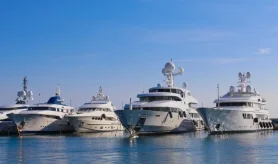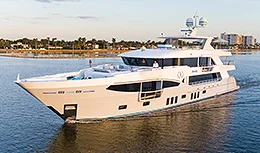- Alaskan Yachts
- Azimut Yachts
- Back Cove Yachts
- Beneteau Yachts
- Benetti Superyachts
- Bertram Yachts
- Boston Whaler
- Broward Yachts
- Buddy Davis Sportfish
- Burger Yachts
- Cabo Yachts
- Catamarans
- Carver Motoryachts
- Center Console
- Chris-Craft Yachts
- Cruisers Yachts
- DeFever Trawlers
- Dufour Sailboats
- Fairline Yachts
- Feadship Yachts
- Ferretti Yachts
- Filippetti Yachts
- Formula Yachts
- Fountaine Pajot Cats
- Grady-White
- Grand Banks Trawlers
- Hargrave Yachts
- Hatteras Yachts
- Hinckley Picnic Boats
- Horizon Yachts
- Hydra-Sports
- Intrepid Boats
- Jarrett Bay Sportfish
- Jeanneau Yachts
- Kadey-Krogen Trawlers
- Lazzara Yachts
- Lekker Boats
- Luhrs Sportfish
- Marlow Yachts
- Maritimo Yachts
- Marquis Yachts
- Mazu Yachts
- McKinna Motoryachts
- Meridian Yachts
- Midnight Express
- MJM Yachts
- Mochi Craft
- Neptunus Motoryachts
- Nordhavn Trawlers
- Nordic Tugs
- Numarine Yachts
- Ocean Alexander Yachts
- Ocean King
- Offshore Yachts
- Outer Reef
- Oyster Sailing Yachts
- Pacific Mariner Yachts
- Palmer Johnson Yachts

TITAN Submarine: What Lies Beneath
Did you know that it’s easier to send a person to space than it is to send one down to the bottom of the deepest part of the ocean?
Or at least, it used to be. Then came the brave new world of submersibles. And the adventure is only just getting started.
“With its untold depths, couldn’t the sea keep alive such huge specimens of life from another age, this sea that never changes while the land masses undergo almost continuous alteration? Couldn’t the heart of the ocean hide the last–remaining varieties of these titanic species, for whom years are centuries and centuries millennia?” – Captain Nemo
When Jules Verne imagined Captain Nemo plunging in the Nautilus to the depths of the ocean in his 1870 novel Twenty Thousand Leagues Under the Sea, little did he know of future human endeavors. Nor the actual depth of the ocean, for the deepest part (the Challenger Deep of the Mariana Trench near Guam in the Pacific) is closer to 20 leagues, but that’s missing the point. The idea that undiscovered life lurks beneath the surface is what fueled his creativity, and it remains the driving force behind Stockton Rush’s work today.
A former aerospace engineer, Rush is the founder of OceanGate Inc., a private company that, with the assistance of NASA’s Marshall Space Flight Center in Huntsville, Alabama, has built TITAN. Constructed out of titanium and filament-wound carbon fiber, TITAN is a Cyclops-class five-person submarine (named after the largest moon of Saturn where life possibly exists).
In May 2021, Rush and a team of ocean explorers will dive 13,123 feet below the surface of the North Atlantic to the UNESCO-protected wreck site of the RMS TITANIC. 106 — 107 Comprising a series of six ‘look and document’ missions, each containing five 12-hour dives, the Titanic Survey Expeditions present a rare opportunity to view (but not touch) the iconic vessel that sank in 1912 after it struck an iceberg. The five-square-mile debris field that surrounds the wreck will also be documented. For Rush, whose two previous attempts to realize the Titanic Expeditions in 2018 and 2019 were thwarted by logistics, it’s been a long time coming.

“More people have climbed Everest in one day than have seen the TITANIC. If you want to do something that is truly unique and also advances human knowledge, then underwater is where you’ve got to do it.”
TITAN, which spent four years in development, is equipped with multiple external cameras, multibeam sonar, 40,000 lumens of external light, a laser scanner and the largest transparent viewports of any deep-diving submersible. The aim of the mission, aside from getting eyes on the most famous wreck in the world, is primarily to document the TITANIC’s current condition, the rate of decay, and then monitor that data year-on-year before the wreck disappears.
“The big question on everyone’s lips is when will the TITANIC no longer be around? At the rate that it’s currently dissolving based on previously captured data, many expect large parts of it to be unrecognizable in 20 years, as it’s being eaten by the recently discovered bacteria, Halomonas titanicae.”

pilot Ofer Ketter
Modern-day submarines have come a long way since the first-ever submersible designed in 1620 by Dutchman Cornelis Drebbel, which was man-powered by oars (the mind boggles). But it’s the same hunger to learn about the creatures of the deep that drives inventors and scientists alike. When marine geologist Heather Stewart – an expert in the geomorphology of subduction trenches – stepped aboard yacht owner Victor Vescovo’s 68m PRESSURE DROP as part of EYOS’ Five Deeps Expedition in 2019, she was clueless to the fact she was about to take her first ever submarine dive in LIMITING FACTOR, a Triton 36000/2.
“We were flying over hotspots of biodiversity in the Arctic ocean, diving to depths of 8,200 feet, which makes me the deepest diving British female,” she enthuses. “For somebody that’s worked for 20 years in the marine environment, it was fantastic to see it for myself.”
Vescovo became the fourth person in history to reach Challenger Deep in 2019, while LIMITING FACTOR, which operates in a marine environment that is the equivalent to 2,200 tons of crushing pressure pushing down on the hatch, has accolades of its own; the world record for deepest diving sub and the only submersible ever certified to unlimited depth.
For Stewart, it was stumbling upon a “carpet of crinoids” while flying over a 20km-wide sea mount that was her highlight. But for submersible pilot Ofer Ketter, who operates the U-Boat Worx Cruise Sub 7 aboard explorer yacht SURI, being part of teams that document new species, including giant jellyfish and deep-water sharks, remains unrivalled.
“In the Galapagos, we confirmed the presence of near-extinct sea cucumbers at 328-feet, and in the Sea of Cortez in Baja California our team of scientists documented a family of grouper that had already been recorded as extinct,” says Ketter, who is based in Costa Rica.

For anyone who braves the deep, a rich world of marine life awaits. “The chance of sighting rare thresher sharks or nautilus in the Solomon Islands, or witnessing unchartered volcanoes, canyons, sea mounts and shipwrecks is extremely high,” he says.
For some people, the thrill is in the technology; for others, it’s the fish. Either way, for those fortunate enough to experience it, the event is otherworldly. “People imagine a sub being this tight, metal can with small windows, but it’s not,” says Ketter. “You’re sitting in a 360-degree cinema.”
Triton describes its newly launched 3300/6 as possessing a “salon under the sea.” It’s the first six-person acrylic-hulled sub ever to be constructed and features the world’s largest transparent, spherical passenger compartment, giving an immersive view to the ocean outside. And Ketter’s luxurious CS7 interior is equipped with revolving leather seats and two large acrylic spheres with enough room for six passengers, in addition to the pilot.
It offers an unparalleled view of never-before-seen reefs and historic wrecks. In fact, submarine diving is so rare in the Pacific territories that Cookson Adventures’ ongoing two-year expedition to Papua New Guinea, Fiji, Tonga, French Polynesia and the Cocos Islands will make a major contribution to Seabed 2030 Project, an international initiative (run by The Nippon Foundation of Japan and the General Bathymetric Chart of the Oceans) that aims to map the whole ocean floor using a multibeam echosounder by the year 2030.
It’s also very safe, explains Ketter, with the vessel kept at an approximate pressure of one standard atmosphere, which is what you feel at the surface. “Guests can go from the jacuzzi to the bottom of the ocean and back to the jacuzzi in total comfort, multiple times, with no preparation required. There’s nothing else out there like it.”






